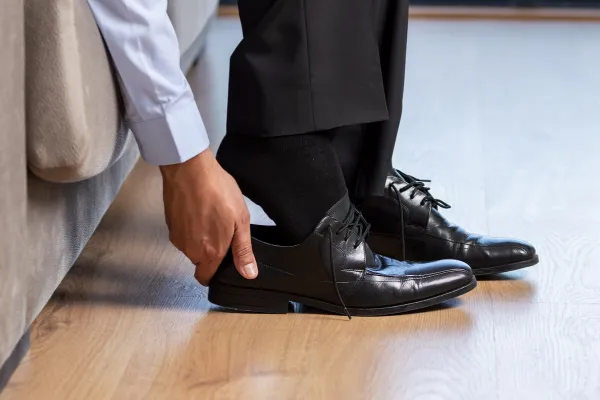
Why Proper Footwear Matters for Ulcer Prevention
If you've ever had a sore on your foot that just wouldn’t heal, you know how scary and frustrating it can be. For people with diabetes, poor circulation, or nerve damage, these kinds of wounds—called foot ulcers—can quickly turn serious.
The good news? Wearing the right shoes can make a huge difference.
Let’s break down how proper footwear helps with ulcer prevention, what to look for in a good shoe, and when it’s time to see a podiatrist for help.
What Is a Foot Ulcer?
A foot ulcer is an open sore or wound that usually forms on the bottom of the foot. They’re especially common in people who have:
Diabetes
Poor circulation
Nerve damage (neuropathy)
Foot deformities or bony pressure points
Because some people can’t feel pain in their feet, they may not even realize they have a problem until the wound becomes infected or deep.
How Do Shoes Play a Role?
Footwear may seem like a small thing—but shoes can either protect your feet or slowly damage them.
Here’s how the wrong shoes can cause problems:
Too tight: They rub against skin and create blisters or pressure sores
Too loose: Your foot slides around, causing friction and skin breakdown
Hard soles or seams: These press on certain spots, especially if you have foot deformities
Poor ventilation: Traps moisture, which leads to skin breakdown and infection
Over time, these small irritations can turn into ulcers, especially if your body has a harder time healing due to diabetes or circulation issues.
What Makes a Shoe “Proper” for Ulcer Prevention?
A good shoe for ulcer prevention does more than just fit well. It’s built to protect your feet from pressure, rubbing, and injury.
Look for shoes that offer:
✅ Plenty of toe room
You should be able to wiggle your toes without feeling cramped.
✅ Soft interior with no seams
Even small seams inside the shoe can cause friction over time.
✅ Cushioned soles
Helps absorb shock and reduce pressure on the bottom of your feet.
✅ Firm heel support
Prevents sliding and keeps your foot stable.
✅ Adjustable closure
Laces or Velcro straps help you customize the fit.
✅ Breathable materials
Keeps feet dry and reduces the risk of fungal infections or skin breakdown.
If you’ve already had an ulcer, your podiatrist might recommend custom diabetic shoes or offloading boots that take pressure off healing areas.
What About Orthotics?
Orthotics (custom inserts) can also help reduce pressure points and support better foot alignment.
They’re especially helpful if you have:
Flat feet or high arches
Calluses or corns
Uneven walking patterns
One leg longer than the other
By correcting how your foot hits the ground, orthotics help you avoid ulcers before they start.
Warning Signs Your Shoes Might Be Causing Problems
You don’t have to wait for a full-blown wound to know something’s off. Here are a few red flags that your shoes might be damaging your feet:
Red marks that don’t fade after removing your shoes
Blisters, calluses, or skin peeling
Tingling, numbness, or burning (especially if you have diabetes)
Toenail problems or pressure sores
Feeling unstable or like your foot is sliding in the shoe
Simple Tips to Keep Your Feet Safe Every Day
You don’t have to buy expensive shoes to protect your feet. It’s more about paying attention and making smart choices. Try these daily tips:
👟 Check your shoes before wearing them
Look inside for pebbles, rough seams, or anything that could rub your skin.
🧦 Always wear clean, padded socks
Avoid tight elastic or rough fabric that can cause friction.
🦶 Inspect your feet daily
Use a mirror to check the bottoms of your feet if needed.
👞 Rotate your shoes
Let shoes air out and dry between uses to prevent moisture buildup.
🩺 See a podiatrist regularly
Especially if you’ve had ulcers before, professional care can help you stay ahead of problems.
When to See a Specialist
If you’ve noticed redness, pain, or an open sore—or if your shoes always seem to cause discomfort—it’s time to visit a podiatrist.
At American Surgeons Group, we help patients every day find the right footwear, prevent serious wounds, and stay mobile and pain-free. Whether you need a shoe fitting, a custom insert, or a plan to heal a stubborn sore, we’ve got your back (and your feet).
Take the First Step Toward Safer, Healthier Feet
Ulcer prevention starts from the ground up—literally. A well-fitting shoe may not seem like a big deal, but for people with foot risks, it’s one of the most powerful tools in staying healthy.
If you’re unsure what shoes are right for your feet—or if you’ve been dealing with foot pain, swelling, or sores—don’t wait. The sooner we catch a problem, the faster we can help.
Call us today or book an appointment to get your feet the support they deserve.
